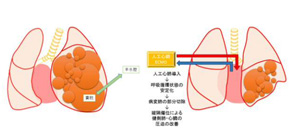
Fetal treatment and partial pulmonary resection with the use of ECMO saved baby with severe CCAM
Successful multidisciplinary treatment initiated by Osaka University Hospital Fetal Treatment Center
A group at the Osaka University Fetal Treatment Center of Hospital provided medical treatment to an unborn baby who was diagnosed with congenital cystic adenomatoid malformation (CCAM) with a large lesion with a CVR of 3.74, accompanying life-threatening fetal edema. In fetal treatment, cyst puncture was performed first, and then a cyst amniotic shunt was placed at 23 weeks of gestation, improving the lesion (CVR=2.2); however, delivery day approached, the lesion exacerbated (CVR=2.61) and the baby was born in critical condition.
After birth, the baby was on an artificial respiration system and received whole body management in an intensive-care unit; however, the lesion and respiratory condition exacerbated, so the baby was on an extracorporeal membrane oxygenator (ECMO) on Day 1. On Day 2, a large part of the affected lower lobe of left lung was resected with the ECMO on. The partial pulmonary resection improved the condition of the baby’s healthy lung and heart, which had been compressed with the lesion (mediastinal shift), weaning the baby from the ECMO on Day 4. On Day 14, the lower lobe of the left lung was resected for radical resection of the remaining lesion site. On Day 29, the baby was weaned from ventilator support, leaving the hospital on May 21 (Day 58). At the time of discharge, the baby didn’t need administration of oxygen, and visual, auditory, and neurological aftereffects were not observed. Currently the baby is doing well at home.
Cases like this one -- fetal treatment (cyst amniotic shunt and steroid therapy to a mother) for an unborn baby with severe CCAM, as well as the post-birth course of treatment including partial pulmonary resection with the support of ECMO -- have not been reported in literature in Japan. Fetal treatment, artificial respiratory control, intensive care, ECMO, and surgeries are associated with a risk for complications; however, the baby in this case left the hospital without any aftereffects. As these treatment methods need a high level of therapeutic technique, only a limited number of institutions can provide these services. Therefore, it is great that this patient, who had received advanced medical care mainly at the Fetal Treatment Center of Osaka University Hospital, left the hospital without aftereffects. This case shows that these methods can be a therapeutic option for unborn babies with the same condition and their families.



Related link
